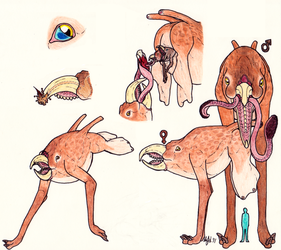Sign In
CloseDuplicitas Corporis "Dual Bodied"
This reptilian-like xenomorph is well adapted to the intense heat of its desert homeworld; so well adapted, in fact, that it is active during the hottest days of the year. It stands at 1'8" to 2' tall, its body and tail together are double its height in length and its second body (also called its false neck) is nearly as long as its body. Its dorsal fin can be up to 1' tall and its patagial membrane can be 2' 6" wide. Its tongue is over a 1' long.
Its long body has an arched spine that keeps its body high off the hot sands and rocks. Its six-toed feet are fringed with lengthened scales that allow it to move over the shifting sands and grip onto the cracks in the parched land with ease. It can also sense the vibrations of oncoming threats through its feet, although it is vulnerable to airborne attacks. It has five elongated ribs along each side of its body that are webbed with patagial skin that stretches to its hips. It can extend these ribs or keep them folded against his sides. It also have spines of movable cartilage alone its back connected by a thin layer of skin that gives way to a sail-fin along its hind end and tail. The spines are venomous, each one having its own individual venom sac at the base of it containing a moderately strong neurotoxin. Should it be stepped on, the victim is in for a nasty surprise, ranging from numbness, pain and swelling to paralysis and intense pain depending on the size and immunity of the victim. It has three spiracles on either side of its torso that are extensions directly from its lungs, allowing it to breathe even as it digs and eats underground. It uses its patagial membranes to move air over these spiracles to cool off the air as it is inhaled, and also to 'smell' pheromones in the air to alert it to possible danger by means of sensitive membranes lining the spiracles. It has cilium lining the spiracles to keep sand out and to absorb tiny plant spores that are carried on the wind.
What appears to be its neck is actually more body, giving it its name, with its front feet being the short arms near its head. This makes it the only known terrestrial hexapod known to science so far. Its false neck is covered in scales that do not overlap arranged in rings around the thin cylindrical shape, which helps it burrow better. The arms are equipped with six long claws that it uses to burrow into sand, rock, and hardened earth. Its neck is actually rather short, and its head is small in comparison to the rest of it. It has a pointed snout that it a shovel shaped head, and lacks eyes, ears, or a nose. Instead, it relies on four sensory organs on its head similar to rhinophores in that they can be extended from small holes in the head and are used to 'smell' pheromones, which is how it locates its prey. Its lower jaw is recessed, so that the mouth is held tightly closed as the head is forced through the ground. The lower jaw and throat are sensitive to vibrations in the ground, and further help it to locate prey. Its mouth is filled with tiny triangular teeth, and it has a long barbed tongue which helps it reach its favorite food, the larvae of the hive vermin which populate large, towering spires. The larvae are generally found near the bottom chambers, so it must burrow until it hits a main tunnel and then use its tongue to reach the larvae, which stick onto the small barbs on its tongue (see figure 1). It will eat any of the hive members that it encounters, though the soldiers can successfully chase it away with their wicked leg scythes.
It can tolerate temperatures as high as 55 Celsius (130 Fahrenheit) but it doesn't do so well with lower temperatures. Its dorsal fin, sail-fin and patagial membranes are all vascularized, and it uses them to cool off during the day by changing its body's orientation to the sun, and extending or contracting its patagial membranes and fins to control how much of its body heat is conducted to the air. When not digging, it holds its false neck and head in a loose coil beneath its body to protect its more sensitive skin by using its own body and patagial membranes as shade (see figure 6). It can change its skin color by means of chromotophores, allowing it to take a lighter hue during the day where it needs to reflect the suns heat, and a darker hue when it needs to conserve heat during the cooler nights. Shade is scarce, but the reptilian can be found circling hive vermin spires to keep the tall pillars between it and the sun. At night, it flattens its belly along the ground and curls its false neck alongside itself, darkens its skin, and folds its patagial membranes against its sides to conserve heat. It keeps its dorsal fin raised at night as protection against nocturnal predators, constricting the blood vessels in the fin so that as little heat is lost as possible (see figure 3).
It is both a hermaphroditic, asexual creature. It can clone itself, or mate with another of its kind, in which both reptilians emerge from the mating pregnant. When it clones itself, it results in a single offspring that inherits the genes from only itself. Offspring resulting from mating will have genes from both parents. Both methods have pros and cons. Cloning is most commonly used as a means of reproduction, simply because coming across another of its own kind in the vast desert is a chance occurrence. When two do come across each other, there is a quick territorial display involving 'necking', or hitting each other with their false necks (see figure 4), presumably to ensure that both are able, strong individuals, and then mating will occur. Their method of mating is quite ridiculous to witness, as they both lean forward on their arms and front legs and lift their hind ends in the air, pushing their cloaca together as they flap their patagial membranes quickly, presumably to compensate for the heat gain that occurs during mating (see figure 5). Once finished, the pair will separate and go in opposite directions. After a two month gestation period, it will give birth to a miniature, fully formed adult that will immediately set off on its own, able to take care of itself. The gestation period for cloned offspring is slightly longer, at two and a half months, and the offspring seem to be slightly larger.
It has a few protections against predator. Its ability to change color allows it to create dark bands along its body. It will flare its patagial membranes, dorsal fin and sail-fin and pump excess blood to them, causing them to turn bright red, and it will flap its patagial membranes rapidly which causes a loud hissing sound. It will curl its head and false neck beneath its body and crouch so that all the predator is faced with is an apparently headless, hissing creature with bright red wings and venomous spines pointed directly at it (see figure 2). Should the predator decide to attack anyways, it will almost certainly be injected with the reptilians neurotoxin. However, not even this unique reptilian is immune to becoming prey on occasion. The entire planet forces its inhabitants to struggle for survival, duplicitas corporis no exception.
Image and Duplicatas Corporis (c) Scott Francis
Submission Information
- Views:
- 422
- Comments:
- 0
- Favorites:
- 2
- Rating:
- General
- Category:
- Visual / Traditional



